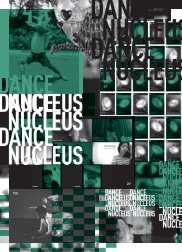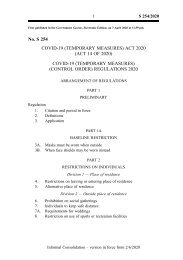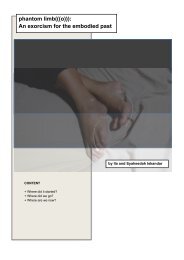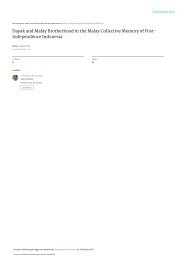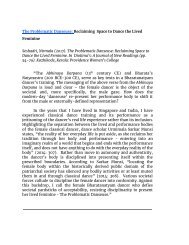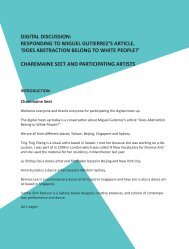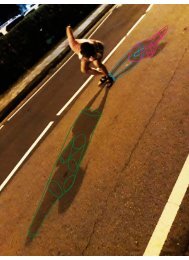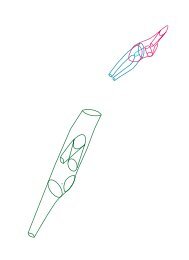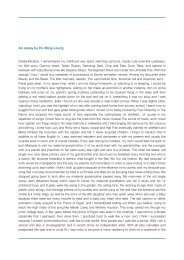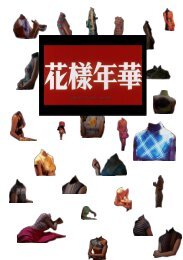FUSE#2
FUSE is a bi-annual publication that documents the projects at Dance Nucleus .
FUSE is a bi-annual publication that documents the projects at Dance Nucleus .
Create successful ePaper yourself
Turn your PDF publications into a flip-book with our unique Google optimized e-Paper software.
Element#2<br />
BAHASA KOREOGRAFI<br />
Malay, Malay Dance:<br />
Three Dimensions<br />
The four young choreographers participating in ELEMENT#2 follow the<br />
complexity of interpreting Malay(ness) pertaining to their respective<br />
cultural contexts in Southeast Asia: Soultari Amin Farid and Norhaizad<br />
Adam are from Singapore, Mohd Fauzi bin Aminudin from Kuala Lumpur<br />
and Ayu Permata Sari yang asal Lampung tetapi menetap di Yogyakarta<br />
selama tujuh tahun terakhir.<br />
Their various constellations can be described as such:<br />
(PRACTICE OF) SILAT DUDUK:<br />
INVESTIGATING MALAY(NESS)<br />
In Singapore, the Malays are a minority race within the population<br />
(vis-a-vis those of Chinese descent who make up the majority), whilst it<br />
is the reverse in Malaysia (the Malays as majority, the Chinese and<br />
Indians are minorities). In these two countries, the word ‘Malay’ refers to<br />
racial identity - with all the consequences of the discriminatory policies<br />
from the state embedded with it. Meanwhile in Indonesia, ‘Malay’ simply<br />
refers to one of its hundreds of ethnicities - not at all a racial identity,<br />
although indeed, it is categorised within the problematic category - the<br />
pribumi.<br />
by Helly Minarti<br />
https://www.amazon.com/Flow-Psychology-Experience-Perennial-Classics/dp/0061339202<br />
In geographical terms, ‘Malay’ in Indonesia refers to the provinces of<br />
Riau, Riau islands and North Sumatra (the Deli part, not other parts<br />
inhabited by the Batak), as the main original locations for the Malays.<br />
But as researched by many scholars (among them Julianti Parani), the<br />
Malays in Indonesia is also spread out in other islands, such as coastal<br />
Kalimatan, Sulawesi, and up to the Molucca archipelago. However,<br />
although the Malays constitutes a minority group, it has a unique place<br />
within the Indonesia's cultural landscape, since the Malay language<br />
(Bahasa Melayu) is the basis for Bahasa Indonesia, the national<br />
language of Indonesia today. Given that the Javanese (with its varied<br />
localities) is the majority group in Indonesia, the adoption of the<br />
language of a small minority proved to be a strategy that prevented<br />
internal conflict, than if Indonesia had made Javanese, the language of<br />
its majority group, the national language instead.<br />
In the two-day workshop, Benny used Minangkabau as an<br />
example to highlight the cultural differences within the<br />
spectrum of Malay groups in Indonesia. (In the context of<br />
Minangkabau dance culture, Malay dance is perceived as<br />
something imported and was only popular in the big cities<br />
back in the 1960s.)<br />
Similarly, Alfian’s lecture on Malay Identity provided a historical<br />
flash back in Singaporean theatre, citing examples of what<br />
was banned, what was perceied as 'kurang ajar' or<br />
obnoxious. This flash back triggered a circle discussion after<br />
the lecture. We discussed issues surrounding the tensions<br />
shaping Malay identity in the arts in Singapore, and how to<br />
articulate effective strategies in navigating politics embedded<br />
in the practice of Malay dance.<br />
The following are the notes from our meetings, conversations<br />
and a series of anecdotes that came up. They help give colour<br />
to what I have discussed above:<br />
Artistic Lineage:<br />
The Bodily Archive and Aspiration to<br />
Discover the Contemporary Body<br />
Tracing one's personal trajectory in a learning process begins<br />
with an awareness and the acceptance that the dancing body<br />
that one inhabits is what one inherits from a certain artistic<br />
lineage, transmitted through a mode of modernity.<br />
In Singapore, this transmission can be community-based<br />
(sanggar in Bahasa Indonesia) or other educational spaces,<br />
such as extra-curricular activities in schools or the university<br />
in the case of Singapore.<br />
25 26




